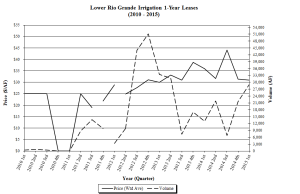Demand for Lower Rio Grande water created a lease market in south Texas. Lease prices vary by use, with agricultural water users typically paying lower rates per acre-foot because they have lower consumptive use of water.
Municipal users have priority in the system, with a municipal reserve of 225,000 AF reestablished each month. Excess water is allocated to irrigators, who must have a balance available in a revolving account to take delivery of water. The long-term average allocation for Lower Rio Grande contracts is 2.5 AF/acre.
Between 2009 and early 2011, water supplies were abundant, so the watermaster was able to provide full allocations (4 AF/acre), and during flood operations at the Falcon and Amistad Dams, the Rio Grande Watermaster provided “free water” that does not count against contractor’s accounts. As a result, leasing activity for irrigation water was sparse during that time. But with a change in hydrology, activity peaked in the fourth quarter 2012, totaling 51,183 AF for just that quarter.
Since then, activity eased somewhat, but has remained high—rivaling or exceeding the amount of activity seen during the drought of the late 1990’s. During the first quarter 2015, leases totaled 29,115 AF—compared to 12,952 AF in the first quarter 2014, 33,377 AF in the first quarter 2013 and 3,300 in the first quarter 2012. In the fourth quarter 2014, leases totaled 21,557 AF.
Prices ranged from $30/AF to $40/AF, with most water trading at the lower end of the range. The average price for the first quarter was $30.91/AF, compared to $31.37/AF in the fourth quarter 2014 and $35.94/AF in the first quarter 2014.
With heavy rains and flooding in the region this spring, expect leasing activity and prices to drop in the short term. But as dry conditions return expect activity and prices to return to a high level, especially if Mexico continues amassing a water debt under the Rio Grande Compact. (For more on Mexico’s failure to satisfy its obligation to provide an average of 350,000 AF per year over five-year cycles, along with discussion of a potential solution, see “Texas Laments Unreliable Water Deliveries from Mexico,” Rodney T. Smith, Hydrowonk Blog, February 11, 2015.)
Written by Marta L. Weismann

You must be logged in to post a comment.